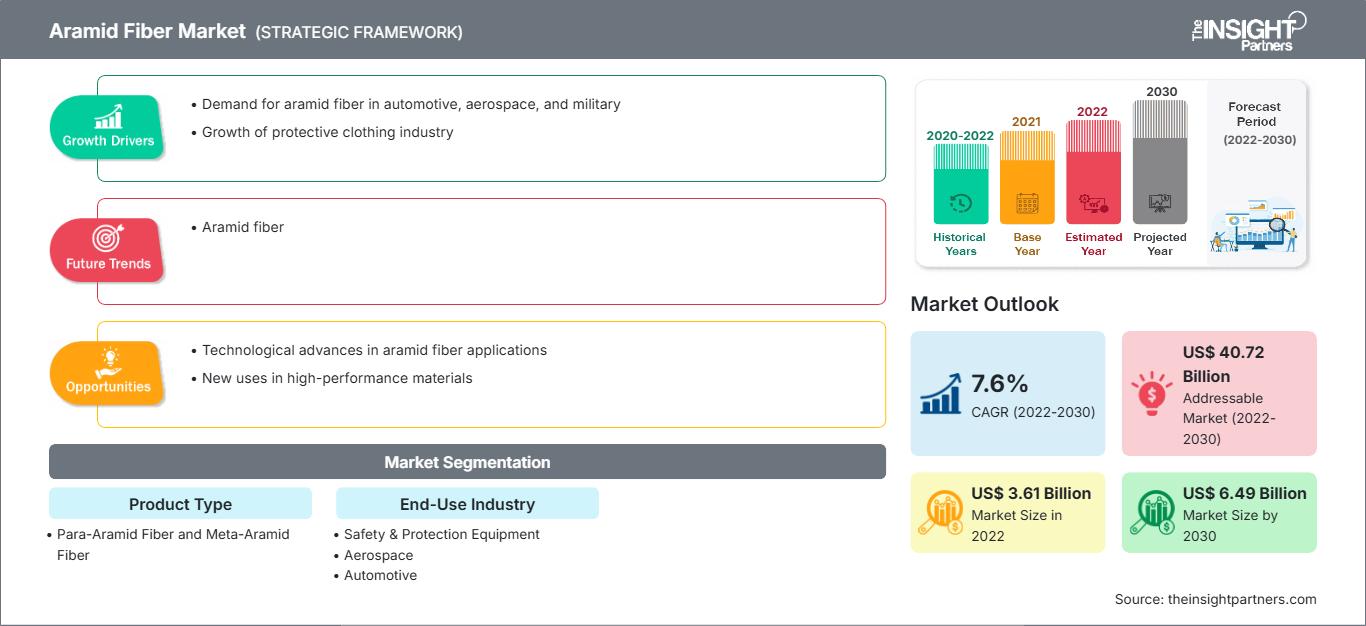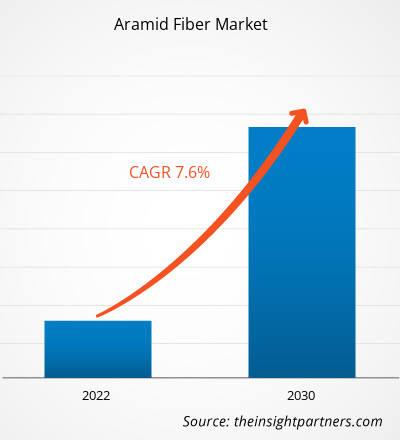[Rapporto di ricerca] Il mercato delle fibre aramidiche è stato valutato a 3,61 miliardi di dollari nel 2022 e si prevede che raggiungerà i 6,49 miliardi di dollari entro il 2030; si stima che registrerà un CAGR del 7,6% dal 2022 al 2030.
Approfondimenti di mercato e punto di vista degli analisti:
Le fibre aramidiche, note anche come poliammidi aromatiche, sono fibre sintetiche con eccezionale resistenza, resistenza al calore e durevolezza. Sono rinomate per la loro elevata resistenza alla trazione, da cinque a sei volte superiore a quella dell'acciaio, e per la loro leggerezza, pari a solo un quinto del peso dell'acciaio. Queste straordinarie proprietà rendono queste fibre preziose per un'ampia gamma di applicazioni, in particolare nei settori che richiedono elevate prestazioni e sicurezza. La struttura unica delle fibre aramidiche contribuisce in modo significativo alle loro eccezionali proprietà. Queste fibre sono costituite da lunghe catene di molecole di poliammide, in cui i legami ammidici sono direttamente legati ad anelli aromatici. Questa disposizione si traduce in una struttura rigida, a forma di bastoncino, che conferisce alle fibre notevole resistenza e rigidità. Inoltre, gli anelli aromatici forniscono intrinseca resistenza al calore e stabilità, consentendo a queste fibre di resistere ad alte temperature senza degradarsi significativamente.
Fattori di crescita e sfide:
La crescente domanda da parte dell'industria automobilistica è stata un importante motore trainante dell'espansione del mercato delle fibre aramidiche. La domanda di queste fibre è aumentata esponenzialmente, poiché le case automobilistiche si concentrano sempre più sulla produzione di veicoli più leggeri e a basso consumo di carburante. L'elevato rapporto resistenza/peso di queste fibre, in particolare delle varianti para-aramidiche, tra cui il Kevlar, consente lo sviluppo di componenti leggeri senza compromettere l'integrità strutturale. Nel settore automobilistico, queste fibre sono ampiamente utilizzate in varie applicazioni, tra cui la produzione di pneumatici, freni, pastiglie e materiali compositi. Il rinforzo di questi componenti con queste fibre ne aumenta la durevolezza e la resistenza all'usura, contribuendo a una maggiore durata e a prestazioni complessive migliori. Inoltre, queste fibre vengono utilizzate nella produzione di compositi per il settore automobilistico, offrendo un equilibrio tra resistenza e peso cruciale per il raggiungimento degli obiettivi di efficienza nei consumi. Pertanto, tutti questi fattori stanno determinando la domanda di fibre aramidiche nel settore automobilistico.
Il mercato delle fibre aramidiche, tuttavia, deve affrontare limitazioni nella crescita a causa della disponibilità di sostituti che offrono proprietà simili o alternative. La fibra di carbonio è uno dei principali sostituti di queste fibre, che condivide alcune caratteristiche con le fibre aramidiche, tra cui elevata resistenza e leggerezza. In alcune applicazioni, i produttori possono optare per la fibra di carbonio come alternativa, soprattutto quando cercano materiali con rigidità o conduttività superiori. Questa concorrenza da parte dei sostituti rappresenta una sfida per l'adozione diffusa di queste fibre, in particolare nei settori in cui entrambi i materiali potrebbero potenzialmente soddisfare le specifiche richieste.
Personalizza questo rapporto in base alle tue esigenze
Potrai personalizzare gratuitamente qualsiasi rapporto, comprese parti di questo rapporto, o analisi a livello di paese, pacchetto dati Excel, oltre a usufruire di grandi offerte e sconti per start-up e università
Mercato delle fibre aramidiche: Approfondimenti strategici

-
Ottieni le principali tendenze chiave del mercato di questo rapporto.Questo campione GRATUITO includerà l'analisi dei dati, che vanno dalle tendenze di mercato alle stime e alle previsioni.
Segmentazione e ambito del rapporto:
L'"Analisi del mercato globale delle fibre aramidiche fino al 2030" è uno studio specializzato e approfondito con particolare attenzione alle tendenze del mercato e alle opportunità di crescita in tutto il mondo. Il rapporto mira a fornire una panoramica del mercato con una segmentazione dettagliata per tipologia di prodotto e settore di utilizzo finale. Il mercato ha registrato una forte crescita nel recente passato e si prevede che questa tendenza continuerà durante il periodo di previsione. Il rapporto fornisce statistiche chiave sul consumo di fibre aramidiche a livello globale. Inoltre, il rapporto fornisce una valutazione qualitativa dei vari fattori che influenzano l'andamento del mercato delle fibre aramidiche a livello globale. Il rapporto include anche un'analisi completa dei principali attori del mercato e dei loro principali sviluppi strategici. Sono incluse anche diverse analisi sulle dinamiche di mercato per aiutare a identificare i principali fattori trainanti, le tendenze di mercato e le opportunità redditizie che, a loro volta, aiuterebbero a identificare le principali fonti di reddito.
L'analisi dell'ecosistema e l'analisi delle cinque forze di Porter forniscono una visione a 360 gradi del mercato, che aiuta a comprendere l'intera catena di fornitura e i vari fattori che influenzano la crescita del mercato globale delle fibre aramidiche.
Analisi segmentale:
In base alla tipologia di prodotto, il mercato è suddiviso in fibre para-aramidiche e fibre meta-aramidiche. In termini di settore di utilizzo finale, il mercato è segmentato in dispositivi di sicurezza e protezione, aerospaziale, automobilistico, elettronica e telecomunicazioni e altri. La sicurezza e la protezione Il segmento dei dispositivi di protezione individuale ha registrato una quota di mercato significativa per le fibre aramidiche nel 2022. Le fibre aramidiche, in particolare le varianti para-aramidiche come il Kevlar, sono rinomate per la loro eccezionale resistenza, l'elevato modulo elastico e la resistenza agli urti, che le rendono ideali per applicazioni in cui sicurezza e protezione sono fondamentali. Questa fibra è ampiamente utilizzata nella produzione di giubbotti antiproiettile e caschi. L'intrinseca resistenza balistica di queste fibre, unita alla loro leggerezza, le rende la scelta preferita per i giubbotti antiproiettile. Le forze armate e le forze dell'ordine di tutto il mondo utilizzano ampiamente dispositivi di protezione a base di fibre aramidiche per fornire al personale una protezione efficace contro le minacce balistiche senza compromettere la mobilità. Tutti questi fattori stanno guidando il mercato delle fibre aramidiche per il segmento dei dispositivi di sicurezza e protezione.
Analisi regionale:
In base all'area geografica, il mercato delle fibre aramidiche è segmentato in cinque regioni chiave: Nord America, Europa, Asia-Pacifico, Sud e Centro America e Medio Oriente e Africa. Il mercato è stato dominato dall'Asia-Pacifico, che ha rappresentato circa 1 miliardo di dollari nel 2022. La regione offre numerose opportunità di crescita. Anche l'aumento degli investimenti diretti esteri contribuisce alla crescita economica della regione. Si prevede che il crescente utilizzo di queste fibre in numerose applicazioni, tra cui componenti automobilistici, elettronica e altre, aumenterà la domanda di fibre aramidiche nell'Asia-Pacifico.
Si prevede che l'Europa registrerà un CAGR di oltre l'8,0% dal 2022 al 2030. Le fibre aramidiche sono fondamentali per la produzione di componenti leggeri ma robusti nelle strutture aeronautiche e nei sistemi di protezione balistica. Poiché l'Europa ospita importanti aziende aerospaziali e un importante settore della difesa, la domanda di fibre aramidiche in questi settori continua a crescere. Inoltre, si prevede che il Nord America raggiungerà circa 1,7 miliardi di dollari nel 2030.
Sviluppi del settore e opportunità future:
Di seguito sono elencate le varie iniziative intraprese dai principali attori che operano nel mercato delle fibre aramidiche:
- Nell'aprile 2023, DuPont de Nemours Inc. ha annunciato il lancio della fibra aramidica Kevlar EXOTM. Kevlar EXO offrirà una combinazione di leggerezza, flessibilità e protezione della fibra aramidica, con la protezione della vita come primo di molti casi d'uso.
Approfondimenti regionali sul mercato delle fibre aramidiche
Le tendenze regionali e i fattori che influenzano il mercato delle fibre aramidiche durante il periodo di previsione sono stati ampiamente spiegati dagli analisti di The Insight Partners. Questa sezione analizza anche i segmenti e la geografia del mercato delle fibre aramidiche in Nord America, Europa, Asia-Pacifico, Medio Oriente e Africa, America meridionale e centrale.
Ambito del rapporto sul mercato delle fibre aramidiche
| Attributo del rapporto | Dettagli |
|---|---|
| Dimensioni del mercato in 2022 | US$ 3.61 Billion |
| Dimensioni del mercato per 2030 | US$ 6.49 Billion |
| CAGR globale (2022 - 2030) | 7.6% |
| Dati storici | 2020-2022 |
| Periodo di previsione | 2022-2030 |
| Segmenti coperti |
By Tipo di prodotto
|
| Regioni e paesi coperti |
Nord America
|
| Leader di mercato e profili aziendali chiave |
|
Densità degli operatori del mercato delle fibre aramidiche: comprendere il suo impatto sulle dinamiche aziendali
Il mercato delle fibre aramidiche è in rapida crescita, trainato dalla crescente domanda degli utenti finali, dovuta a fattori quali l'evoluzione delle preferenze dei consumatori, i progressi tecnologici e una maggiore consapevolezza dei vantaggi del prodotto. Con l'aumento della domanda, le aziende stanno ampliando la propria offerta, innovando per soddisfare le esigenze dei consumatori e sfruttando le tendenze emergenti, alimentando ulteriormente la crescita del mercato.

- Ottieni il Mercato delle fibre aramidiche Panoramica dei principali attori chiave
Impatto del COVID-19:
La pandemia di COVID-19 ha avuto un impatto negativo su quasi tutti i settori industriali in diversi paesi. Lockdown, restrizioni di viaggio e chiusure aziendali in Nord America, Europa, Asia-Pacifico (APAC), America Meridionale e Centrale e Medio Oriente e Africa (MEA) hanno ostacolato la crescita di diversi settori, tra cui quello chimico e dei materiali. La chiusura delle unità produttive delle aziende produttrici di fibre aramidiche ha compromesso le catene di approvvigionamento globali, le attività produttive e i tempi di consegna. Diverse aziende hanno segnalato ritardi nelle consegne dei prodotti e un calo delle vendite nel 2020. La maggior parte degli impianti di produzione industriale è stata chiusa durante la pandemia, riducendo il consumo di queste fibre. Inoltre, la pandemia di COVID-19 ha causato fluttuazioni nei prezzi delle fibre aramidiche. Tuttavia, diversi settori hanno ripreso le loro attività dopo la risoluzione dei vincoli di fornitura, il che ha portato a una ripresa del mercato dei contenitori in plastica. Inoltre, la crescente domanda di queste fibre da parte dell'industria automobilistica sta promuovendo in modo sostanziale la crescita del mercato delle fibre aramidiche.
Panorama competitivo e aziende chiave:
DuPont de Nemours Inc, Teijin Limited, Yantai Tayho Advanced Materials Company, Hyosung Corporation, Toray Industries Inc, Kolon Industries, Huvis Corporation, China National Bluestar (Group) Co Ltd, Taekwang Industrial Co Ltd e Kermel SAS sono tra i principali attori che operano nel mercato globale delle fibre aramidiche. Gli attori del mercato globale si concentrano sulla fornitura di prodotti di alta qualità per soddisfare la domanda dei clienti.
- Analisi storica (2 anni), anno base, previsione (7 anni) con CAGR
- Analisi PEST e SWOT
- Valore/volume delle dimensioni del mercato - Globale, Regionale, Nazionale
- Industria e panorama competitivo
- Set di dati Excel
Report recenti
Rapporti correlati
Testimonianze
Motivo dell'acquisto
- Processo decisionale informato
- Comprensione delle dinamiche di mercato
- Analisi competitiva
- Analisi dei clienti
- Previsioni di mercato
- Mitigazione del rischio
- Pianificazione strategica
- Giustificazione degli investimenti
- Identificazione dei mercati emergenti
- Miglioramento delle strategie di marketing
- Aumento dell'efficienza operativa
- Allineamento alle tendenze normative






















 Ottieni un campione gratuito per - Mercato delle fibre aramidiche
Ottieni un campione gratuito per - Mercato delle fibre aramidiche